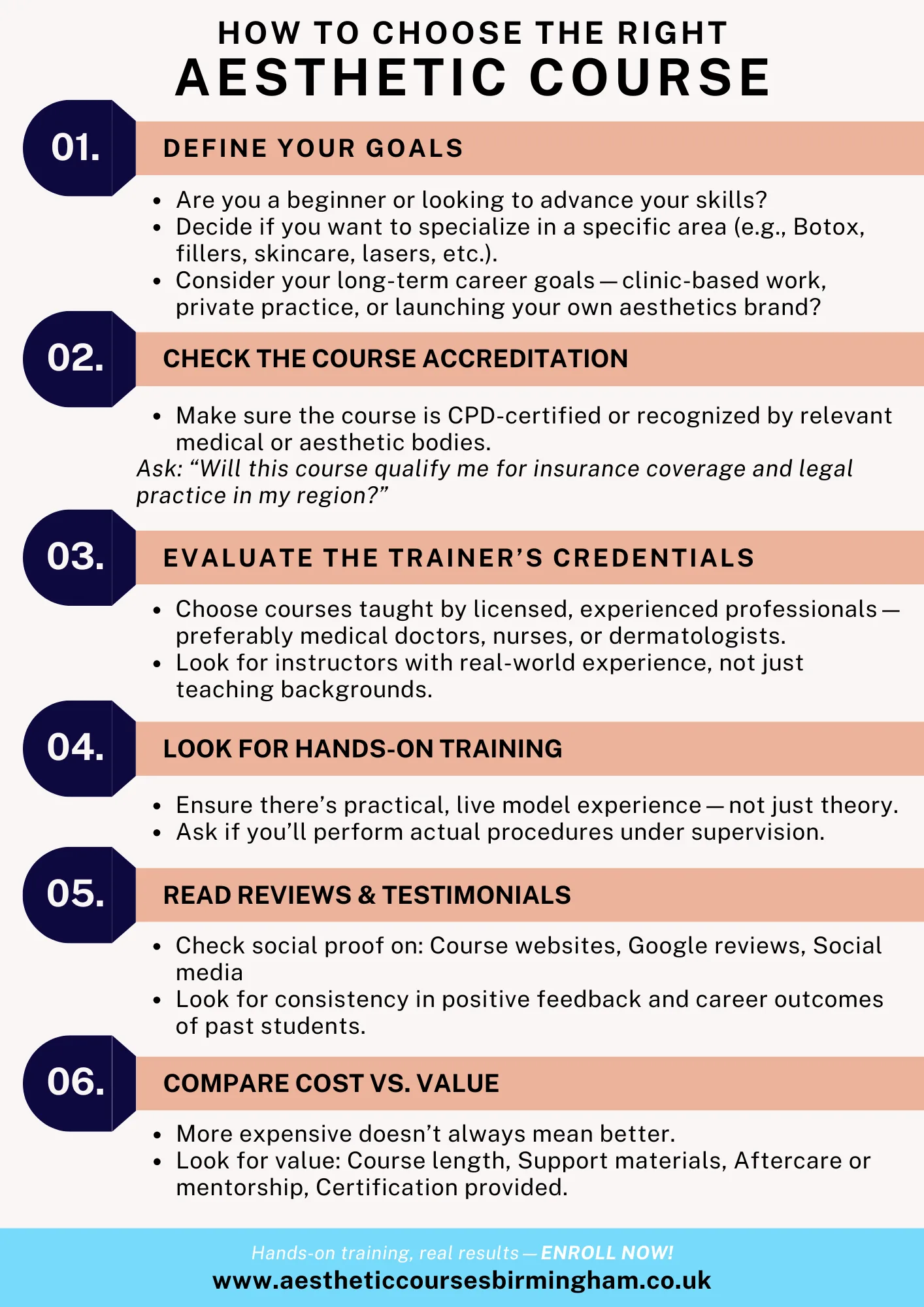
With the demand for non-surgical beauty treatments booming, now is the perfect time to learn how to master dermal fillers. From understanding facial anatomy to learning safe, confidence-boosting techniques, filler training opens the door to a rewarding and fast-growing field.
In this guide, you’ll discover exactly what these courses cover, who they’re designed for, and how to kick-start your journey into aesthetics—with skill, precision, and style.
Key Takeaways
- Aesthetic filler courses provide practical and theoretical training for safe injection techniques.
- Accreditation is crucial for ensuring the quality and recognition of your training.
- Different types of courses cater to various skill levels, from beginners to advanced practitioners.
- Ongoing education is important in the ever-evolving field of aesthetics to stay updated on best practises.
- Cost considerations include tuition fees and additional expenses like materials and insurance.
Understanding Aesthetic Filler Courses
Overview of Aesthetic Filler Courses
Aesthetic filler courses is a growing field, and there’s definitely a demand for skilled practitioners. But where do you start? Well, aesthetic filler courses are your gateway.
Aesthetic courses are designed to give you the knowledge and practical skills you need to safely and effectively administer dermal fillers. Think of them as your foundation for a successful career in aesthetic medicine. They cover everything from the basics of facial anatomy to advanced injection techniques.
Importance of Accreditation
Okay, listen up, because this is important: accreditation matters. Seriously. When you’re looking at aesthetic filler courses, make sure they’re properly accredited.
Why? Because accreditation means the course has met certain standards of quality and safety. It means the instructors are qualified, the curriculum is up-to-date, and you’ll actually learn what you need to know. Plus, many insurance companies and employers will only recognise qualifications from accredited courses.
Types of Aesthetic Filler Courses
There’s a whole range of aesthetic filler courses out there, so you can find one that fits your needs and experience level. You’ve got:
- Foundation Courses: These are for beginners with little to no experience in aesthetics. They’ll cover the basics of facial anatomy, injection techniques, and safety protocols.
- Advanced Courses: Designed for practitioners who already have some experience with fillers and want to learn more advanced techniques, such as treating specific areas of the face or using different types of fillers.
- Specialised Courses: These focus on specific types of fillers or treatments, such as lip fillers or non-surgical rhinoplasty. If you want to become an expert in a particular area, these are the courses for you.
Choosing the right type of course depends on your current skill level and your career goals. Think about what you want to achieve and then find a course that will help you get there.
Key Skills Acquired in Aesthetic Filler Training
Injection Techniques and Safety
First and foremost, you’ll learn the proper injection techniques. This isn’t just about sticking a needle in someone; it’s about precision, control, and understanding the different layers of the skin.
Safety is paramount, so you’ll cover things like:
- Sterilisation protocols
- Managing complications (what to do if something goes wrong)
- Choosing the right needle and product for each area
- Understanding product rheology and its impact on injection technique
Facial Anatomy and Physiology
Think back to biology class! A good course will give you a solid grounding in facial anatomy. You’ll learn about the muscles, blood vessels, and nerves in the face.
Why is this important? Because knowing where these structures are helps you avoid them during injections. It’s all about minimising risk and achieving the best possible results. You’ll cover:
- Detailed muscle anatomy and function
- Vascular mapping of the face
- Nerve distribution and potential injury points
- Age-related changes in facial structure
Consultation and Patient Care
It’s not just about the injections themselves. A big part of being a successful practitioner is being able to consult with patients effectively. This means:
- Understanding their concerns and expectations
- Assessing their facial structure and skin quality
- Explaining the procedure in a clear and understandable way
- Managing their expectations and providing aftercare advice
Communication is key. You need to be able to build trust with your patients and make them feel comfortable. This includes discussing potential risks and side effects, as well as managing their expectations about the results.
Ultimately, aesthetic filler training is about more than just learning how to inject. It’s about developing a holistic skillset that will allow you to provide safe, effective, and ethical treatments to your patients.
Choosing the Right Aesthetic Filler Course

With so many options out there, how do you pick the right one? It can feel a bit overwhelming, but don’t worry, we’ll break it down.
Factors to Consider When Selecting a Course
Okay, first things first, what do you need from a course? Think about your current skill level. Are you a complete beginner, or do you have some experience already? This will help you narrow down the options. Also, consider what specific filler treatments you’re most interested in learning.
Here’s a few things to think about:
- Accreditation: Is the course properly accredited? This is super important, as it shows the course meets certain standards.
- Course Content: Does the course cover the theory and practical skills you need? Check the syllabus carefully.
- Location and Timing: Does the course fit into your schedule and is it in a location that works for you?
Evaluating Course Providers
Right, so you’ve got a rough idea of what you’re looking for. Now it’s time to check out the course providers themselves. Do a bit of digging.
- What’s their reputation like?
- Do they have good reviews from previous students?
It’s also worth checking out the trainers. What are their qualifications and experience? You want to learn from the best, right?
Understanding Course Formats
Finally, think about the course format. Do you prefer to learn in person, or would you rather do an online course? Some courses are a mix of both, which can be a good option.
Also, consider the length of the course. Some are just a day or two, while others are spread out over several weeks. Pick a format that suits your learning style and schedule.
Choosing the right aesthetic filler course is a big decision, but by considering these factors, you’ll be well on your way to finding the perfect one for you. Good luck!
The Structure of Aesthetic Filler Courses
It’s good to know what to expect in terms of how the course is actually structured. It’s not just about watching someone inject filler; there’s a lot more to it. Let’s break down the typical components you’ll find.
Theoretical Learning Components
First up, the theory. This part is usually delivered through lectures, online modules, or even workshops. You’ll be covering a lot of ground here, from facial anatomy to the different types of fillers available.
It’s not the most exciting part for everyone, but it’s essential for understanding what you’re doing and why. Expect to learn about:
- The science behind fillers and how they interact with the skin.
- Potential complications and how to manage them.
- Legal and ethical considerations in aesthetic practise.
Don’t underestimate the importance of the theoretical side. It’s the foundation upon which your practical skills will be built. A solid understanding of anatomy, product knowledge, and safety protocols is what separates a good practitioner from someone who’s just winging it.
Practical Training Sessions
Practical training involves hands-on experience, usually starting with mannequins before moving on to real patients. You’ll be supervised by experienced trainers who will guide you through various injection techniques. These sessions are designed to build your confidence and refine your skills.
You’ll likely cover:
- Basic injection techniques (linear threading, bolus, fanning).
- Treatment of different facial areas (lips, cheeks, nasolabial folds).
- Managing patient expectations and achieving natural-looking results.
Assessment and Certification
Finally, there’s the assessment. This is how the course provider ensures you’ve met the required standards. Assessments can take various forms, including written exams, practical demonstrations, and case studies.
If you pass, you’ll receive a certificate, which is your proof that you’ve completed the training. Expect:
- A final practical exam where you’ll treat a patient under supervision.
- A written exam to test your knowledge of theory.
- Feedback from your trainers on your performance and areas for improvement.
Advancing Your Career with Aesthetic Filler Courses
Aesthetic filler courses aren’t just about learning a new skill; they’re a launchpad for career growth. The aesthetics industry is always changing, and continuous learning is key to staying ahead.
Let’s look at how these courses can help you move forward.
Opportunities for Specialisation
Once you’ve got the basics down, the world of aesthetic fillers opens up. You can choose to specialise in specific areas or techniques. For example, you might focus on lip fillers, facial contouring, or even treatments for specific skin types.
Specialisation allows you to become an expert in a niche, attracting a specific clientele and potentially commanding higher fees.
Here are a few specialisation options to consider:
- Lip Augmentation: Mastering different lip filler techniques.
- Non-Surgical Rhinoplasty: Using fillers to reshape the nose.
- Cheek Augmentation: Creating volume and definition in the cheek area.
Networking and Professional Development
Aesthetic filler courses aren’t just about the practical skills; they also provide opportunities to network with other professionals in the field. You’ll meet trainers, mentors, and fellow practitioners, all of whom can be valuable resources as you build your career.
Attending industry events, workshops, and conferences is a great way to stay connected, learn about new trends, and even find potential job opportunities or collaborations.
Building a Client Base
One of the biggest challenges for any aesthetic practitioner is building a solid client base. Aesthetic filler courses can help with this in a few ways.
- Firstly, they give you the skills and confidence to deliver excellent results, which leads to happy clients and word-of-mouth referrals.
- Secondly, some courses include training on marketing and business management, teaching you how to attract and retain clients.
Consider offering introductory discounts or package deals to attract new clients initially. Here are some ways to build your client base:
- Offer free consultations to potential clients.
- Create a strong online presence with before-and-after photos.
- Ask satisfied clients for testimonials and referrals.
Cost Considerations for Aesthetic Filler Courses
Embarking on aesthetic filler training is an investment in your career, but it’s important to understand the costs involved. Let’s break down what you can expect to pay and how to budget effectively.
Tuition Fees Breakdown
Tuition fees for aesthetic filler courses can vary quite a bit depending on several factors. These include the course level (foundation, advanced, or specialist), the duration of the course, the reputation of the training provider, and the location.
Generally, you can expect to see a range like this:
- Foundation Courses: These entry-level courses, often lasting one to three days, can range from £800 to £2,000.
- Advanced Courses: Focusing on more complex techniques or specific areas, these might cost between £1,000 and £3,000.
- Specialist Courses (e.g., Level 7): These in-depth qualifications can be a more significant investment, potentially costing from £3,000 to £7,000 or more.
It’s worth checking exactly what the tuition fee includes. Does it cover all learning materials, access to equipment, and models for practical sessions? Some courses might have hidden extras, so always read the fine print.
Additional Costs to Anticipate
Beyond the headline tuition fees, there are other costs you’ll need to factor in. Don’t get caught out!
- Materials and Equipment: Some courses might require you to purchase your own starter kit of needles, syringes, and other consumables. This could add a few hundred pounds to your expenses.
- Travel and Accommodation: If you’re travelling to a course, remember to budget for transportation and accommodation. Look for courses local to you to minimise these costs.
- Insurance: You’ll need appropriate insurance to practise, and some courses might require you to have it in place even for the training. Check what’s needed and factor in the cost of a suitable policy.
- Models: While some courses provide models for practical sessions, others might ask you to source your own. If so, consider the cost of compensating your models for their time and any products used.
It’s easy to focus solely on the tuition fee, but these additional costs can quickly add up. A bit of careful planning can make a big difference to your overall budget.
Budgeting for Your Training
Creating a budget is key to managing the financial aspect of your aesthetic training. Here’s a simple approach:
- Research Course Costs: Get detailed information on tuition fees and what they include.
- Estimate Additional Expenses: Make a list of all potential extra costs (materials, travel, insurance, etc.) and estimate how much they’ll be.
- Explore Funding Options: See if there are any grants, loans, or payment plans available to help spread the cost.
- Set a Savings Goal: Work out how much you need to save each month to cover your training expenses.
By taking a proactive approach to budgeting, you can make your aesthetic filler training dreams a reality without breaking the bank.
Continuing Education in Aesthetic Medicine
The world of aesthetic medicine is constantly evolving, with new techniques, products, and regulations emerging all the time. Continuing education is vital for staying at the forefront of the industry and providing the best possible care for your clients. Think of it as an investment in your future success.
Importance of Ongoing Training
Let’s be honest, what you learn in your initial course is just the foundation.
Ongoing training helps you:
- Refine your injection techniques for better results and reduced risk.
- Expand your knowledge of facial anatomy and physiology to make informed decisions.
- Stay updated on the latest safety protocols and guidelines.
- Learn about new products and technologies as they become available.
- Maintain your professional credibility and meet regulatory requirements.
Keeping your skills sharp and your knowledge current isn’t just about ticking boxes; it’s about providing the safest, most effective treatments for your patients and building a thriving practise.
Advanced Courses and Masterclasses
Once you’ve got the basics down, consider specialising in specific areas. Advanced courses and masterclasses can help you:
- Master advanced injection techniques for specific areas like lips, cheeks, or tear troughs.
- Learn how to correct complications and manage adverse reactions.
- Develop expertise in non-surgical procedures like chemical peels or micro-needling.
- Gain a deeper understanding of skin ageing and rejuvenation.
- Explore combination therapies for enhanced results.
Staying Updated with Industry Trends
Beyond formal courses, there are plenty of ways to stay informed about the latest developments in aesthetic medicine:
- Attend industry conferences and workshops to network with peers and learn from experts.
- Subscribe to professional journals and online resources to stay up-to-date on research and best practises.
- Participate in online forums and discussion groups to share knowledge and experiences.
- Follow key opinion leaders and influencers in the field on social media.
- Engage in continuous professional development (CPD) activities to maintain your certification and demonstrate your commitment to lifelong learning.
Conclusion
Stepping into the world of aesthetic fillers can be both exciting and transformative. With the right training, you’ll gain the confidence, skills, and knowledge to start building a future in one of the fastest-growing areas in beauty and aesthetics.
For those ready to take the first step, a range of aesthetic filler courses is available—designed especially for beginners seeking hands-on guidance, expert-led instruction, and real-world application. The journey into aesthetics begins HERE—on your own terms, and at your own pace.
Frequently Asked Questions
What are aesthetic filler courses?
Aesthetic filler courses teach you how to safely inject fillers into the skin to enhance beauty. These courses cover everything from the basics to advanced techniques.
Why is accreditation important for these courses?
Accreditation ensures that the course meets certain quality standards. It helps you know that you are getting proper training from qualified instructors.
What types of aesthetic filler courses are available?
There are different types of courses, including beginner, intermediate, and advanced levels. Some focus on specific techniques, while others cover a broader range of topics.
What skills will I learn in an aesthetic filler course?
You will learn important skills like how to inject fillers safely, understand facial anatomy, and how to consult with patients effectively.
How do I choose the right aesthetic filler course for me?
Consider factors like the course content, the experience of the trainers, and whether the course is accredited. It’s also important to think about the format, such as online or in-person.
What are the costs associated with aesthetic filler courses?
Costs can vary widely. Besides tuition, you should also budget for materials, insurance, and any additional training you may need.







